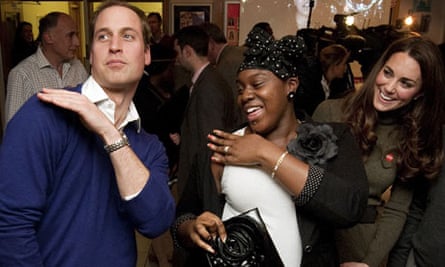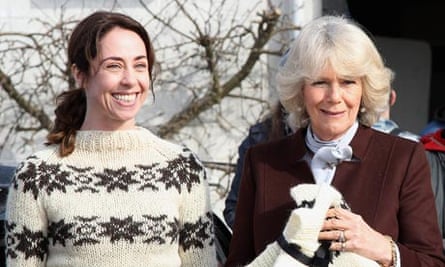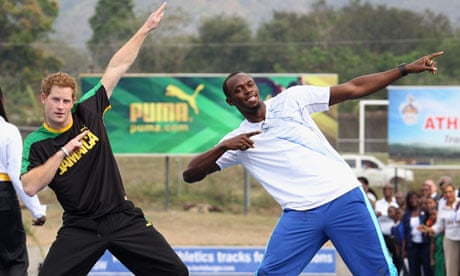The other day, Cheryl Cole had a lovely dream. "I married Prince Harry and was a real-life princess," she said. "It's true. And Charles was my father-in-law." The last bit sounds like every girl's nightmare, but that's not important now.
More important are the ramifications of this dream for the British constitution. Until very recently, pop stars didn't dream of marrying members of the royal family, still less blab about it. The royals were too tweedy and facially equine for such dreams to do anything but damage a pop chanteuse's fanbase. But all that has changed. How? There are two possibilities. One: the Clarence House press team have implanted electrodes in Cole's brain to make her have sexy Harry dreams as part of a PR campaign to rehabilitate the royals. Two: there is no PR campaign and the spate of recent stories that have made the royals seemingly ordinary and likable are coincidences, and it's also coincidental that all this is happening in the jubilee year. (This is the explanation that the Clarence House press team favours.)
"Of course there's a policy," says former BBC royal correspondent Jennie Bond. "The young royals are making the monarchy enormously cool." And if there's anything that Jennie Bond, who once ate witchetty grubs in the jungle as Ant and Dec looked on, doesn't know about cool, we'd rather not hear about it. Graham Smith, head of anti-monarchy pressure group Republic, agrees. "There is, after all, a good reason for the intense PR campaign being run by the palace: it knows the public are fast losing interest in the royals, and that as the Queen nears the end of her life any residual affection for her is unlikely to transfer to her son and heir," he writes in the New Statesman. Smith argues that at least a quarter of Britons believe we'd be better off without the monarchy, more than half want an end to its state funding and two-thirds want the royal household opened up to more scrutiny. Maybe, just maybe, making the royals cool could reverse that alleged decline in interest.
It seems only five minutes ago that Prince Harry was a swastika-sporting throwback who called his Asian friend "paki". Three stories show how his image has changed. During his tour of the Caribbean, Harry traded groovy moves with Jamaican sprinter Usain Bolt, yielding the kind of picture spreads of which no previous British prince, with the possible exception of Henry, Prince of Wales, circa 1505, would have been capable. Then Harry emerged from a 4am lock-in at a bar called Bunga Bunga, dancing to his waiting car like any other twentysomething English yeoman off his head on too much pop. In the third story, he rode across a polo field during a match in Brazil to rescue an unconscious US businessman. How moist Cheryl Cole's palms must have become when she read of Harry in sexy boots and tight trousers thundering across the turf like a hottie knight of yore to resuscitate a prone plutocrat. True, some journalists have doubted whether Harry really did revive Bash Kazi. But, in PR terms, this is irrelevant.
Harry's rehabilitation looks like part of a bigger campaign to make the royals seem normal, while paradoxically – and this would be a brilliant campaign if it could be pulled off – glamourising them and reinforcing their regal status. "It's a marvel to behold," says PR expert Mark Borkowski, "and it seems to be working. What you have now is an amazing PR turnaround in an infinitesimally small amount of time."
The branding of Kate, Duchess of Cambridge, is key to this turnaround. She is simultaneously our future queen, the world's hottest magazine cover girl and a woman feted as a cut-price royal who, while William was bravely defending the Falklands from wicked Sean Penn, modestly made her debut as a public speaker wearing her mother's hand-me-down dress in, there's no easy way to say this, Ipswich. But the older royals are part of the PR makeover too. Witness Camilla on the set of zeitgeisty Danish cop show The Killing earlier this month, where she was given a Faroe Isle cardigan from the show's star, Sofie Gråbøl, who is so proverbially badass that her name rhymes with trouble. Was the historic moment when the Duchess of Cornwall went gangsta for the British monarchy, pointing Gråbøl's (replica) gun at the cowering Crown Princess Mary of Denmark, proof that the British royal family has replaced their smug, cycling, attractive Danes as Europe's coolest rulers? Maybe, if it weren't for Prince Charles, the unreconstructed exception to the new royal rule. (When he visited William Wordsworth's home last week, he was told that the deer were eating the daffodils. Shoot them, he suggested.)
Charles notwithstanding, could the rehabilitation of the royals really be a concerted campaign? If so, then the safe money says Morrissey is part of it. Earlier this month, members of his band appeared on stage wearing "We hate William and Kate" T-shirts. There's little more likely to perk up anything than Morrissey's opprobrium. To find out if the royal PR machine is running a secret rebranding campaign flouting the wishes of a considerable proportion of British taxpayers, I ring Clarence House, which looks after public relations for the Prince of Wales, the Duchess of Cornwall, the Duke and Duchess of Cambridge and Prince Harry. "A lot of the events you're talking about will have come from the principals themselves," says spokeswoman Laura. "The Duchess of Cornwall wanted to visit the set of The Killing. She's a fan." Laura denies Clarence House has a plan to rehabilitate the royals and says someone will get back to me with a fuller denial later.

While I wait for that denial, I phone Ingrid Seward, editor of Majesty magazine, for the royal skinny. "The advisers used to be these ghastly rah-rahs who were all frightfully frightfully," she says. "But they've gone, and the structure of how they work has changed. The monarchy has to evolve and become as touchy feely as the rest of the population. That's easy for William and Harry, but not for the Queen. When you're an 85-year-old you're taught not to show your emotions. You don't hug anything but animals."
Who, then, is rebranding the royals? Among Clarence House's leading advisers is Jamie Lowther-Pinkerton, 51, who has been private secretary to Charles, Camilla, Kate, William and Harry since 2005. This former SAS hardman was described by Tatler as "one of the most trusted men in England – the modern equivalent of a Roman emperors' barber who holds a knife so close to the throat of the kings, but never even nicks the skin". Not only is he the go-to guy to take down Colombian drug barons, but he also coached Ewan McGregor and Charley Boorman in risk assessments for their Long Way Round and Long Way Down TV series. He now advises Harry and William, helping the former to moderate his reputation for being a playboy prince.
Clarence House's press team has been headed since 2003 by Paddy Harverson, 49, a former Financial Times journalist who was for three years Manchester United's director of communications, dealing with such PR nightmares as Sir Alex Ferguson kicking a boot at David Beckham's head. When he left Old Trafford, Ferguson reportedly told him: "You're going to the only place madder than Manchester United." At Clarence House, Harverson has presided over a rapprochement in relations between the tabloids and Harry and William.
One key Clarence House appointment was Miguel Head, 34, former Ministry of Defence press officer, as assistant press secretary. Head is seen as typical of the less stuffy breed of adviser the princes have come to rely on. "Both of those guys are completely under the parapet," says Mark Borkowski. "Paddy Harverson's predecessor was Mark Bolland, whose problem was that he became the story. Harverson would never let that happen to him. Under him, the two boys who, because of how the media treated their mother and them after her death, were very suspicious of the press, had to recognise the importance of the media. Under Harverson they've become both open and controlled in dealing with the press, while seeming normal."
But isn't there a tension for the monarchy in all this? Victorian thinker Walter Bagehot distinguished the dignified from the efficient parts of the constitution. By the former he meant the monarchy, which has a symbolic function; by the latter he meant parliament and government. If the royals seem ordinary, the dignified part of the constitution could be doomed. Where, after all, is the dignity in Harry spilling out of a lock-in evidently plastered?

Bond thinks otherwise. She argues that if the monarchy has a future then members of the royal family must be like us but cooler. "Not long ago they seemed to be the most dysfunctional family on the planet. Now they're cool. It's brilliant. I think the biggest enemy is apathy among young people." But what about dignity? Not an issue. Indeed Bond suggests that on her watch the royal family were terrible at affecting to be ordinary. "I remember being on the set of EastEnders with the Queen in the pub, but she didn't drink her whisky. On another occasion, they went to a drive-through McDonalds but didn't order anything. You've either got to do these things properly or not do them at all. The royal press people will not do image. That's what they say." But what they say and what they do, Bond suggests, are different. She was herself once called in by Prince Charles's private secretary to discuss why he was perceived in a negative way. "I generally felt he needed to loosen up and be less stiff." If he took the advice, I missed it.
Clarence House still hasn't called back, so I read Grazia's meditation on Middleton's haggling skills under the headline "Arise, cut-price Kate". Ever since the royal wedding last year, she has been feted for her populist devotion to high-street brands such as Whistles, LK Bennett and Reiss, but here she's revealed as so fashion-frugal that she wore a "pre-loved" dress by Jesiré at a National Portrait Gallery function.
Could there be better PR for the royal family than this report suggesting that Kate's a savvy bargain hunter with a voguish line in fiscal restraint? No matter that it's freaky rather than frugal to wear your mother's dress (particularly when it didn't fit). No matter that her mum has an estimated fortune of £30m, or that she has married into one of Britain's wealthiest families, or that she has an apartment in Kensington Palace and will move to Buckingham Palace when she becomes our queen. No matter at all. She's just like you and me. The reports over Easter that William and Kate returned from their skiing holiday on EasyJet and that Harry was flying to Romania on Wizz Air have only added to that feeling. We await the sight of Prince Andrew on a Boris bike.
The theme has even been taken up by east London rapper Dizzee Rascal. When Harry met Dizzee in 2009, Dizzee reflected: "That is proper royalty, man! We just had a bit of banter and that. It was mad. He was … a bit like me, really." Andrew Marr, too, has played a part in this celebration of royal normalcy. With his BBC documentary and allied book, The Diamond Queen, he has made the royal family seem human – a service, which, one day, someone will do for him. In one scene William was worrying that courtiers had given him a list of invitees he'd never heard of for the wedding. He called his grandmother for advice and she told him to ignore it and invite who he wanted. Top lady.
In his foreword to the new edition of The Enchanted Glass: Britain and its Monarchy, Tom Nairn, professor of politics at the University of Durham, argues that the Crown is hard at work re-establishing itself as a 21st century enterprise. That involves a "theatre of populism ... a modernising exhibitionism that deliberately underestimates the factors of tradition and retrospect that national identity requires". Any rebranding of the royals is, in other words, risky. For Nairn, the populist new royals may make Britain seem less backward while actually making it more so. They hold us down while seeming to perk us up. "Nearly all commentators predict Great Britain's continued decline, as ex-imperial status turns into increasingly unavoidable marginality, screened by special relationships, the Commonwealth, and other old club subscriptions," he writes. What is the role of the monarchy amid this? For Nairn it is to help Britons pretend that we aren't marginal in the modern world, to enchant us with the lie-dream of importance. He adds: "Prince William and Catherine Middleton can't help falling into a trap formed of the hysteria of counter-decline and a wilful failure to quit a darkening stage."
"The hysteria of counter-decline." The phrase captures what official Britain is like in 2012, as it swaggers Olympian, as David Cameron insists we must put the "great" back into Great Britain and as the royals get rehabilitated. All three help Britain in its deluded sense of self-importance. If only Cheryl Cole's dream was realised and she married Prince Harry, that would help us sustain the delusion longer.
Finally, James from Clarence House calls. "There's no concerted strategy," he says. "We can't strategise their lives." But, with all due respect, you would say that, wouldn't you – especially if there was a strategy? That noise on the other end of the line is probably James's eyes rolling. "The royals are the ones who lead the way. They support the causes they want to promote and we support them." He can't make Harry marry Cheryl, which is a shame.
James says that in the past six to eight weeks there has been a spate of royal stories linked to the Duchess of Cornwall's engagements and Harry's first overseas tour. These, he says, may make it look like there is a PR strategy when there is none. "The [members of the] royal family through their upbringing have been subject to a lot of the influences everybody else has. They have a lot of the same interests as a lot of people."
If Clarence House isn't the PR brain behind the rehabilitation of the royals, who is? Royal historian Robert Lacey has a suggestion. "It's linked with the Queen delegating and outsourcing more to the new generation – that's really the theme of how this jubilee is different from its predecessors," he says. Lacey argues that the Queen learned her populist PR skills from her grandfather, George V. "During his reign, other royal families in Austria and elsewhere were being toppled and his aim was to save ours. To do that he realised he must stop the monarchy seeming to be at the top of the social pile and make direct links to popular feeling, and to connect it with the ordinary people directly. That's why he did radio broadcasts and introduced the OBE and the CBE to honour ordinary people's achievements."
The Queen, Lacey says, is similar. "Like him she's apparently stuffy but nimble, and very responsive to how society has changed. She is rebranding the royal family from behind the scenes to ensure it survives. The Queen is the unsung PR genius behind all this."

Comments (…)
Sign in or create your Guardian account to join the discussion